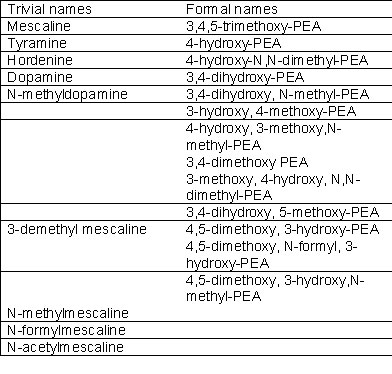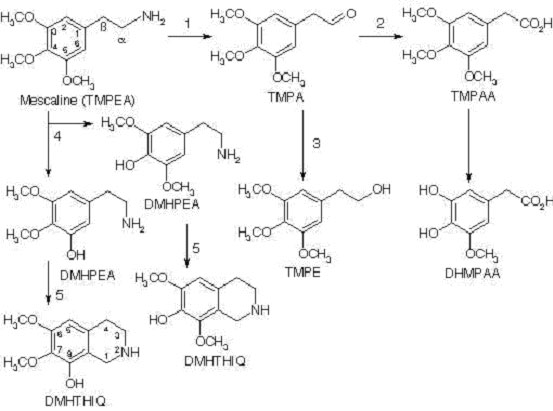|
INTRODUCTION:
Peyote (Lophophora williamsii grows in South-Eastern America and in northern regions of Mexico. In Mexico, peyote has been used for divination in shamanic rituals and in the treatment of ailments for at least 10,000 years. 3, 5
Fray Bernardino de Sahagun and Francisco Hernandez (1570-1577) were priests that tried to document the medical knowlegde of the South American Indians and wrote about the hallucinogenic intoxication caused by peyotl (as the plant was refered to in Nahuatl language)5,10. V.A. Reko has translated a paragraph from Sahagun's 'Historia Universalis' concerning the precolumbian use of Peyotl: "Er macht Visionen, er gibt Kraft, Labt keine Furcht aufkommen, kein durst. Bewahrt den Korper vor aller Gefahr".
Hernandez has written of the intoxicating cactus in his 'Rerum Medicarum Novae Hispaniae Thesauyrus': "Dieser Wurzel werden wunderbare Eigenschaften zuschrieben, wenn man dem Glauben schenken will, was darüber gesagt wird. Diejenigen, die sie nehmen, bekommen die göttliche Gabe der Vorhersehung und können künftige Dinge wie Propheten voraus wissen.... Die Chichimeken glauben, dab die kraft dieser wurzel das ermöglicht. Sie ist recht unscheinbar und ragt kaum uber den Erdboden hervor". 10
In 1953, Aldous Huxley described his mescaline experiences very vividly in the 'The Doors of Perception' and 'Heaven and Hell'.
Effects:
Luxuriant visual- and auditory hallucinations, alteration in space- and time perception, sensations of weightlessness, macropsia, depersonalisation. Mescaline has stimulating effects in lower- and sedative effects in higher doses.
Autonomic changes: nausea, pupillary dilation, increased pulse rate and blood pressure, elevated body temperature, profuse sweating, tremor and the threshold for elicitation of the knee jerk is decreased.
Duration:
The effects appear within two hours after ingestion and last for four to twelve hours.
Dosage and preparation:
The chlorophyllous part of the cactus (buttons) should be cut from the root and can be chewed fresh, or in their dried state, but it can also be prepared as a tea.
4-30 buttons produce psychedelic effects. Fresh peyote contains 0.4 % mescaline per weight, dried buttons 2.74-3.7%. Mescaline itself is fysiologically active between 200-500mg.
Botanical aspects:
L. Williamsii belongs to Cactaceae; Cactoideae, Tribus Cerereae, subtribus Echinocacteninae. It is indigenous to central Mexico and teritory noth to southern Texas and New Mexico. Peyote is a small gray-green desert cactus, which has tufts of cotton like material instead of thorns. Its white/pink flowers appear from the centre of the top and after pollination pink seed capsules appear. Reproduction follows through seeds. Seed germination requires a humid, warm environment (18-25 °C) and may last up to several weeks.
Phytochemistry :
The peyote cactus contains more than 50 alkaloids that are derived from the amino acids tyrosine, phenylalanine. Most of the alkaloids are b-phenylethylamines, but a minor fraction is of the isoquinoline-structure.
Mescaline is the main active principal. Fresh peyote contains 0.4 % mescaline per weight, dried buttons 2.74-3.7%.

Table 1.15: b-Phenyletylamines derivatives (PEA's)


Table1.16: Tetrahydroisoquinoline derivatives (THIQ's)

Pharmacology:
Many of the b-phenylethylamines are physiologically active, but mescaline is mainly responsible for the psychedelic effects. Although mescaline is structurally related to dopamine and noradrenaline it is considered that a bioactivated metabolite of mescaline, 3,4,5-trimethoxyphenyl-acetaldehyde, interferes with the noradrenergic- and dopaminergic pathways.
Mescaline is highly cross-tolerant with LSD and elevates free fatty acids in a similar way as adrenaline.2
It appears that the tetrahydroisoquinoline derivatives (THIQ's) are not major contributors to the peyote experience, but most of them have not been pharmacologically tested.3 The most studied tetrahydro-isoquinolines probably is pellotine. It produces sedativity when taken orally in lower doses (15-30mg.) and produces sleep when injected subcutaneously in higher doses (50 mg.), but no psychological symptoms like mescaline.8
Anhalonidine acts in a similar way as pellotine, but it it less potent: a sedating dose consists of 100-250mg. Lophophorine is one of the more toxic THIQ's studied: It produced severe vaso-dilation, a decreased heartrate and increased blood pressure, but also no psychological symptoms.
Ring closure of mescaline's terminal nitrogen with formaldehyde or acetaldehyde in vivo could also lead to the formation of tetrahydro-isoquinolines. It appears that these compounds are somehow connected to the Parkinson's disease, because pretreatment with the acetaldehyde-condensed compound (1-methyltetrahydro-isoquinoline) prevents some of the damaging effects of MPTP (1-methyl-4-phenyl1,2,3,6-tetra-hydropyridine), a selective neurotoxine that depletes dopamine.

Figure: Biotransformation of mescaline
Modifiers:
Potentiators of the mescaline experience:
- Atropine (Atropa belladonna, Datura- and Brugmansia species).3, 5
- Amphetamine and amphetamine-like stimulants (Ephedra species).
- Diehazine (diparcol).2
- MAO-inhibitors are dangerous, because tyramine is present!2, 5
- Hashish or marihuana usually produces a positive feeling.
Antagonizers:
- Barbiturates (sodium amytal); very effective.
- Tricyclic anti-depressants; very effective.2, 9
- Succinate.2
References
1. [Gottlieb]
2. [Hoffer/ Osmond, 1967]
3. [Hoffmann/ Schultes, 1973]
4. [Niesink/ Vries/ Hollinger, 1995]
5. [Ratsch, 1998]
6. [Shulgin, 1997]
7. [Snyder, 1996]
8. [Stafford, 1974]
9. [Wells, 1973]
(Text by Wout.)
|





